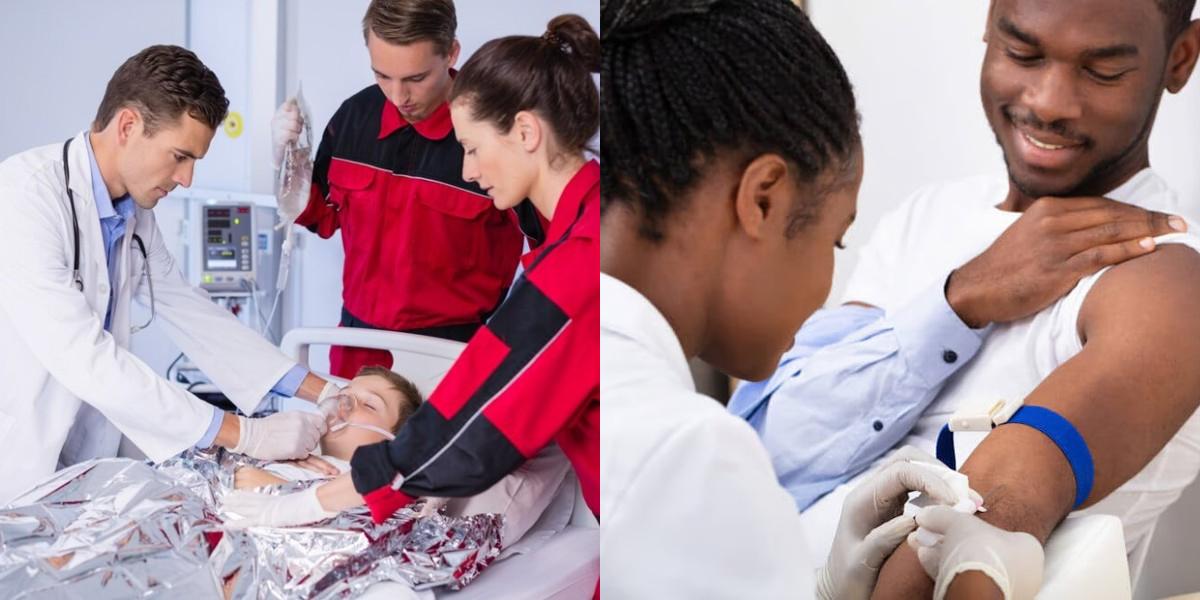PALS vs Phlebotomy (2024)

Want personalized recommendations?
Let's match you to the right program

Key Points:
- PALS providers care for critically ill children, while Phlebotomists collect blood samples for testing.
- PALS providers typically earn higher salaries than Phlebotomists, due to the specialized skills required.
- Phlebotomist jobs are more widely available than PALS provider positions, which are more specialized.
- PALS training is typically in-person, while Phlebotomy training can be done online or in-person.
- PALS training is generally more expensive and takes longer to complete than Phlebotomy training.
Vocational training programs offer a wide range of career opportunities for individuals looking to enter the healthcare field. Two popular options are Pediatric Advanced Life Support (PALS) and Phlebotomy. While both professions involve working in a medical setting, they have different job responsibilities and required training. In this blog post, we will explore the differences between PALS and Phlebotomy, as well as the job outlook and salary potential for each profession.
Article continues after recommendations
Recommended for you
What is PALS and Phlebotomy?
Before we delve into the differences between PALS and Phlebotomy, let's first understand what each profession entails:
PALS: Pediatric Advanced Life Support (PALS) is a specialized training program designed to equip healthcare providers with the skills and knowledge needed to respond to emergency situations involving infants and children. PALS certification is typically required for healthcare professionals who work in pediatric intensive care units, emergency departments, and other settings where pediatric patients may require advanced life support.
Phlebotomy: Phlebotomy is the practice of drawing blood from patients for various medical purposes, such as diagnostic testing, transfusions, or research. Phlebotomists are responsible for properly collecting and labeling blood samples, ensuring patient comfort and safety during the procedure. They may also be involved in processing and transporting the collected blood specimens to the laboratory.
PALS vs Phlebotomy
PALS is specialized training for healthcare providers to manage critically ill pediatric patients, focusing on advanced life-saving techniques in emergency and intensive care settings. Phlebotomy involves the practice of drawing blood from patients for medical testing or donations, requiring specialized training and certification. Both roles are crucial in healthcare but differ in focus: PALS on pediatric emergency care and Phlebotomy on blood collection and laboratory procedures.
Difference between PALS and Phlebotomy
While both PALS and Phlebotomy involve working in a medical setting, there are several key differences between the two professions:
-
Job Responsibilities:
-
PALS professionals are trained to handle emergency situations involving pediatric patients. They are responsible for assessing the patient's condition, initiating resuscitation efforts if necessary, and providing advanced life support interventions.
-
Phlebotomists primarily focus on drawing blood from patients. They must ensure proper collection techniques, maintain sterile equipment, and accurately label and transport the collected specimens.
-
-
Work Environment:
-
PALS professionals typically work in hospitals, pediatric clinics, and emergency departments. They may also be part of medical response teams that provide emergency care outside of healthcare facilities.
-
Phlebotomists can work in a variety of healthcare settings, including hospitals, clinics, diagnostic laboratories, and blood donation centers. They may also provide in-home phlebotomy services for patients who are unable to visit a healthcare facility.
-
-
Training and Certification Requirements:
-
PALS certification requires healthcare professionals to complete a specialized training course that focuses on pediatric emergency care. The course covers topics such as recognizing and treating respiratory distress, cardiac arrest, and shock in pediatric patients. Certification is typically valid for two years and may require renewal through continuing education credits.
-
Phlebotomists can enter the field through various training paths, including vocational programs, community colleges, or on-the-job training. Certification is not always required, but many employers prefer to hire certified phlebotomists. Professional organizations, such as the American Society for Clinical Pathology, offer certification exams for phlebotomy technicians.
-
PALS vs Phlebotomy: Job Description
Now that we have a better understanding of PALS and Phlebotomy, let's take a closer look at the job descriptions for each profession:
PALS Job Description:
- Assessing pediatric patients' vital signs and overall condition
- Administering cardiopulmonary resuscitation (CPR) if necessary
- Managing airway and breathing interventions, such as intubation or ventilation
- Administering medications and fluids as prescribed
- Collaborating with other healthcare professionals to provide comprehensive care to pediatric patients in emergency situations
Phlebotomy Job Description:
- Greeting and preparing patients for blood collection procedures
- Identifying patients and verifying their identities
- Selecting and preparing the appropriate collection equipment
- Drawing blood from patients using venipuncture or capillary puncture techniques
- Properly labeling and documenting collected specimens
- Ensuring the cleanliness and maintenance of phlebotomy equipment and work area
Get courses selected just for you
Try our powerful search engine
Article continues after recommendations
More recommendations for you
PALS vs Phlebotomy: Education and Training
The educational requirements and training for PALS and Phlebotomy differ significantly:
PALS Education and Training:
- PALS certification is typically obtained by healthcare professionals who have already completed their primary education and training in a relevant field, such as nursing or emergency medicine.
- The PALS training course is usually offered as a two-day workshop, where participants learn about pediatric emergency care protocols, algorithms, and interventions.
- Training may include hands-on practice with life support equipment, simulations, and case studies to enhance the participant's ability to respond effectively in real-life emergency situations.
Phlebotomy Education and Training:
- Phlebotomy training can be completed through various educational pathways, including vocational schools, community colleges, or hospital-based programs.
- The duration of phlebotomy training programs can range from a few weeks to several months, depending on the program and the level of certification desired.
- Training typically includes classroom instruction in medical terminology, anatomy, and phlebotomy techniques, as well as hands-on practice in simulated or clinical settings.
- Some programs also include an internship or externship component, where students gain practical experience under the supervision of experienced phlebotomists.
PALS vs Phlebotomy: Career Outlook and Salary
Both PALS and Phlebotomy offer promising career opportunities, but the job outlook and salary potential may vary:
PALS Career Outlook and Salary:
- The demand for healthcare professionals with PALS certification is expected to remain strong, especially in pediatric units and emergency departments.
- PALS professionals can also pursue opportunities in pediatric transport teams, pediatric intensive care units, and pediatric specialty clinics.
- According to the Bureau of Labor Statistics (BLS), the median annual wage for registered nurses, which includes professionals with PALS certification, was $75,330 as of May 2020.
Phlebotomy Career Outlook and Salary:
- The demand for phlebotomists is projected to grow at a faster-than-average rate, driven by an aging population and increased demand for diagnostic testing.
- Phlebotomists can find employment in hospitals, clinics, laboratories, and blood donation centers.
- According to the BLS, the median annual wage for phlebotomists was $36,320 as of May 2020.
Final Thoughts
Choosing the right vocational training program is an important decision that can shape your future career path. PALS and Phlebotomy offer unique opportunities for individuals interested in the healthcare field. Whether you prefer working with pediatric patients in emergency situations or have a passion for drawing blood, both professions have their own set of rewards and challenges. Consider your interests, skills, and long-term goals to make an informed decision about which path is right for you.
Dreambound's educational programs are available in diverse locations. Explore these recommended blogs for a comprehensive examination of the two vocations, including in-depth insights into their prerequisites and guidance on initiating your journey:

Joanna Paragas is part of the Growth team at Dreambound. Her primary role involves creating various automation to streamline workflows and make tasks more efficient for the entire team. Beyond her professional endeavors, Joanna enjoys spending her free time playing with her dogs and enhancing her knowledge by enrolling in online courses.




